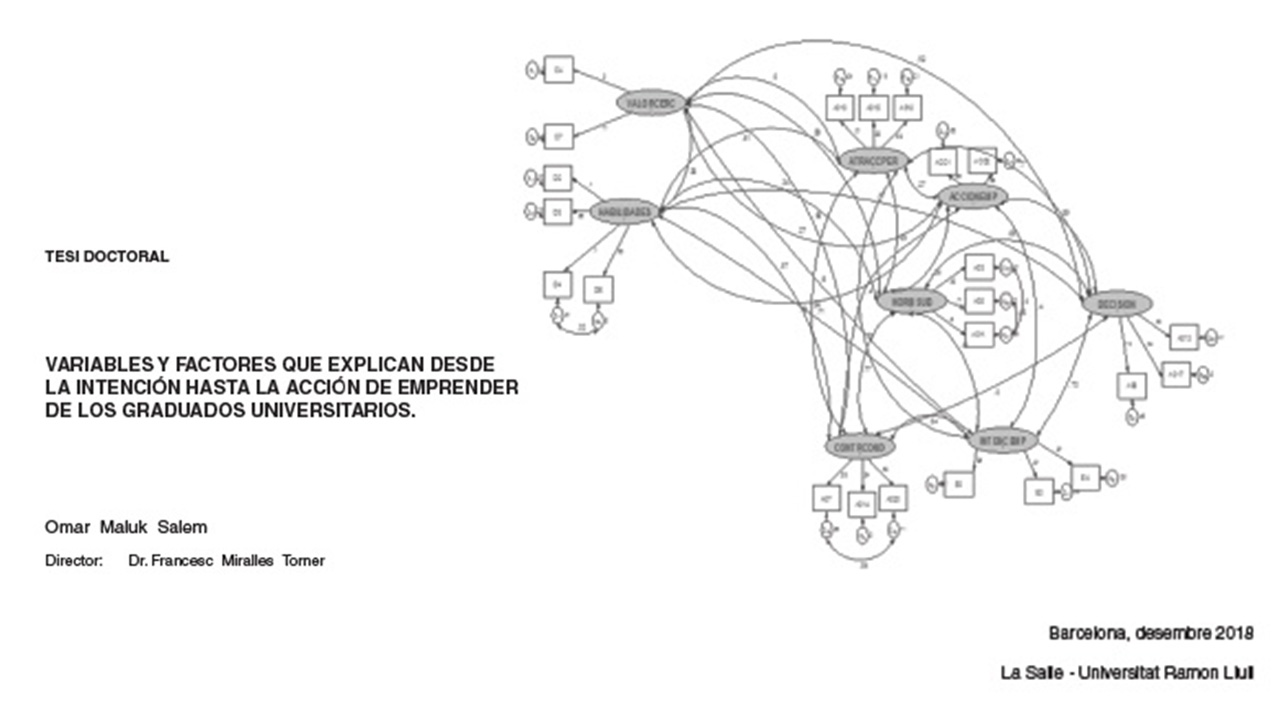MR. OMAR ALDO MALUK’S THESIS LECTURE

ABSTRACT
Cognitive models of business intention have been used to understand entrepreneurial characteristics. These models propose using entrepreneurial intention as a good proxy for entrepreneurial action.
The studies of entrepreneurial behavior have reached the traditional entrepreneurial intention, but some authors mention the need to study in more detail the entrepreneurial behavior and the factors that condition it.
Although the entrepreneurial intention has been defined as the moment in which the individual decides to initiate the entrepreneurial act, it is not clear how this intention evolves to arrive at the action of creating a new company, and consequently to arrive at the final entrepreneurial behavior.

The objective of this work is to better understand the process of forming business intentions. That is, the different states that an individual follows to start an entrepreneurial event.
According to the model of the theory of planned behavior (TPB) (Ajzen & Fishbein, 1980, Ajzen I, 1987, Ajzen I, 1991) which has been applied by some authors to measure the entrepreneurial intention of university students, in this document, this analysis extends to university graduates who finished university and are in the labor market.
Our results show that the entrepreneurial decision variable exhibits a greater variance and constitutes a more advanced moment than the intention in the process of entrepreneurial behavior formation.
The entrepreneurial decision was introduced taking as reference the behavioral work of the planned behavior model (TPB) that has been used by Bentler & Speckart (1981), Ajzen & Madden (1986), Sánchez R (2005), Krueger & Brazeal (1994)), Liñán (2008) and Miralles et al (2016), as well as the entrepreneurial event prepared by Shapero A (1975) and modified by Shapero & Sokol (1982) and consumer behavior by Vermeir & Verbeke (2006).
A first model was obtained under TPB, with the business decision as the final dependent variable, which shows that the entrepreneurial intention is a partial mediating variable for the decision to be an entrepreneur, and then to reach the second model with entrepreneurial action as a variable end of the complete model.
Using the model based on the structural equations method (SEM), it was determined that the entrepreneurial intention has a positive effect on the entrepreneurial decision and that the latter is a total mediator to reach entrepreneurial action.
Key words: entrepreneurial intention, entrepreneurial decision, entrepreneurial action, theory of planned behavior (TPB), business graduates, structural equation model (SEM), entrepreneurial action.
Cognitive models of business intention have been used to understand entrepreneurial characteristics. These models propose using entrepreneurial intention as a good proxy for entrepreneurial action.
The studies of entrepreneurial behavior have reached the traditional entrepreneurial intention, but some authors mention the need to study in more detail the entrepreneurial behavior and the factors that condition it.
Although the entrepreneurial intention has been defined as the moment in which the individual decides to initiate the entrepreneurial act, it is not clear how this intention evolves to arrive at the action of creating a new company, and consequently to arrive at the final entrepreneurial behavior.
The objective of this work is to better understand the process of forming business intentions. That is, the different states that an individual follows to start an entrepreneurial event.
According to the model of the theory of planned behavior (TPB) (Ajzen & Fishbein, 1980, Ajzen I, 1987, Ajzen I, 1991) which has been applied by some authors to measure the entrepreneurial intention of university students, in this document, this analysis extends to university graduates who finished university and are in the labor market.
Our results show that the entrepreneurial decision variable exhibits a greater variance and constitutes a more advanced moment than the intention in the process of entrepreneurial behavior formation.
The entrepreneurial decision was introduced taking as reference the behavioral work of the planned behavior model (TPB) that has been used by Bentler & Speckart (1981), Ajzen & Madden (1986), Sánchez R (2005), Krueger & Brazeal (1994)), Liñán (2008) and Miralles et al (2016), as well as the entrepreneurial event prepared by Shapero A (1975) and modified by Shapero & Sokol (1982) and consumer behavior by Vermeir & Verbeke (2006).
A first model was obtained under TPB, with the business decision as the final dependent variable, which shows that the entrepreneurial intention is a partial mediating variable for the decision to be an entrepreneur, and then to reach the second model with entrepreneurial action as a variable end of the complete model.
Using the model based on the structural equations method (SEM), it was determined that the entrepreneurial intention has a positive effect on the entrepreneurial decision and that the latter is a total mediator to reach entrepreneurial action.
Key words: entrepreneurial intention, entrepreneurial decision, entrepreneurial action, theory of planned behavior (TPB), business graduates, structural equation model (SEM), entrepreneurial action.